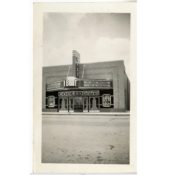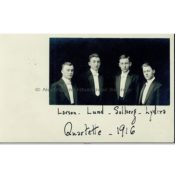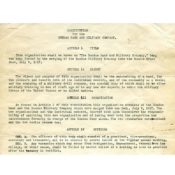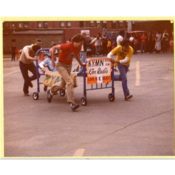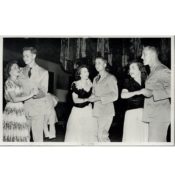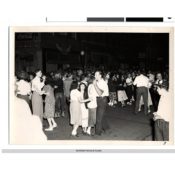
By Stephanie Hess, Northfield-Rice County Digital History Collection, January 2019
The Northfield area has offered many types of entertainment throughout its history. From the beginning, arts and culture have been important to the people who live here.
Northfield’s first community club was the Northfield Lyceum Society, founded in 1856. The Lyceum Society built a small wood-framed building to hold debates, concerts, and dramas in 1857. By 1872, this building was too small to entertain Northfield’s growing population.
That year, Ephraim Lockwood built the Lockwood Opera House above his grocery store on Division Street. It hosted traveling theater companies, musicians, and comedians. The Lockwood also showed Northfield’s first motion picture in 1896.
A. K. Ware opened his 800-seat Ware Auditorium in 1899. Here, audiences watched operas, plays, and school performances. The Ware Auditorium also began projecting motion pictures in 1904. It was renamed the Grand Theater in 1917 and showed movies at its site until 1985.
Other movie houses opened in Northfield in the early twentieth century. In 1909, the Gem Theater began showing films on the west side of the Cannon River. The Lyric Theater and the West Theater soon followed. Northfielders young and old flocked to these theaters during their free time.
Northfield is also known as a musical town, thanks in part to its colleges. Both St. Olaf College and Carleton College have included music since the 1870s. St. Olaf’s music department gained worldwide fame under the direction of F. Melius Christiansen. He founded the St. Olaf Choir in 1912 and led both the band and the choir on nationwide and international tours.
Community members joined musical groups, as well. They became members of church choirs, community bands, drum and bugle corps, and small ensembles. They joined for their own enjoyment and to entertain their neighbors.
The Northfield Arts Guild formed in 1959 as a community-wide arts organization. It created classes and groups for visual arts, dance, music, theater, and creative writing. Its leaders and teachers have come from Carleton and St. Olaf Colleges as well as the wider Northfield area.
Radio provided new ways for Northfielders to be entertained. Both St. Olaf and Carleton Colleges had radio programs which broadcast well beyond campus. The city also got a local radio station in 1968 when KYMN-1080 AM radio was formed. For over 50 years, this station has served as both a source of information and entertainment for local citizens.
Finally, Northfielders have always enjoyed live performances. People have come together to watch parades, skating demonstrations, pageants, bank raid reenactments, and dramas. They have gotten to know each other at dances, debates, concerts, jam sessions, art classes, and festivals.
With so many types of entertainment in Northfield, the arts are clearly an important industry in the area. In every era, entertainment has raised the quality of life of Northfield’s residents.
Primary Sources
Discussion Questions
When you look at the individual items in the Northfield-Rice County Digital History Collection, use the zoom-in tool to view details in the images or more easily read the documents. Use the tab labeled “TEXT” to read full transcriptions of the documents.
Questions
- The word “entertainment” is defined by Dictionary.com as “something that amuses, pleases, or diverts, especially a performance or show.” Dictionary.com also defines the word “leisure” as “freedom from time-consuming duties, responsibilities, or activities” like a job. How are “leisure” and “entertainment” related?
- How do you spend your free time? Looking at the examples above, describe how people in Northfield spent their free time over its history. How was entertainment different in the past? How is it the same?
- Why do you think people made time in their lives for entertainment and leisure? What does it say about their values, their lifestyle, and their culture?
- What factors affected the leisure time activities of people in Northfield? Consider factors like eras, gender, religion, ethnic background, socioeconomic status, age, and more.
- How did technology contribute to changes in how Northfield people were entertained?
- Would you enjoy being a member of the Lyceum Society in the 1850s, where entertainment consisted of an intellectual debate on current events? Why or why not? Why do you think people in the 1850s enjoyed this type of entertainment?
- The Northfield Arts Guild formed, in part, to provide more ways for people in the community to participate in creating arts of all kinds. Why is this significant? Compare the benefits of participatory entertainment vs. passive entertainment.
- How did movies and movie-going influence the young people in Northfield in the early 20th century?
- How did the wide variety of types of entertainment help people escape their everyday realities?
- Why is the history of entertainment significant? What can leisure time activities tell us about a community like Northfield in general?
Related Items in the Northfield-Rice County Digital History Collection
Defeat of Jesse James Days photographs
Music in Northfield documents and photographs
Northfield Arts Guild collection (minutes, programs, newsletters, posters, and more)
Northfield Lyceum constitution, bylaws, and minutes
Northfield Women and Pre-Code Hollywood: Housewives, Fanettes, and The Silk-clad Movie Stars
Our Northfield-Made Children: Young People and Movie-going in 1930’s Northfield
“Pioneers Enjoyed Mental Exercises of Old Lyceum“, in the Early Northfield History scrapbook by Emily Bierman
St. Olaf music history photographs
Additional Resources
Lesson Plans and Teacher Guides
Bruce, Charlotte and Helen Stephan. Twentieth Century Entertainment: When Work is Done. Lesson plan developed for the Library of Congress. Web (accessed Nov. 8, 2018).
Davis, Kay. Having Fun: Leisure and Entertainment at the Turn of the Twentieth Century. Lesson plan developed for the EDSITEment! program of the National Endowment for the Humanities, Nov. 13, 2009. Web (accessed Nov. 8, 2018).
Bibliography
Cantwell, Dick, ed. Northfield Arts Guild, the first 40 years: A Documentary Compilation of Images and Reminiscences, 1960-2000. Northfield, MN: Northfield Arts Guild, 2000. Available online (accessed June 26, 2018).
Donelan, Carol. Electric Theater: The Emergence of Cinema in Northfield, 1896-1917. Northfield, MN: Northfield Historical Society, 2011.
Hvistendahl, Susan. Historic Happenings, Vol. I & Vol. II: Selected Entertainment Guide columns. Northfield, MN: Northfield Historical Society Press and The Entertainment Guide, 2014-2015.
Hvistendahl, Susan. The Lyceum: Northfield’s Oldest Building, Built in 1857. Northfield, MN: Northfield Historical Society, 2010.
Kane, Lucile M. and John A. Dougherty. “Movie Debut: Films in the Twin Cities, 1894-1909.” In Minnesota History, Vol. 54 Issue 8, Winter 1995, pp. 342-358. Available online (accessed June 5, 2018).
“Movies and the Movie-going Experience of the 1930’s.” Minnesota Historical Society. Web (accessed June 5, 2018).
Northfield Bicentennial Committee. Continuum: threads in the community fabric of Northfield, Minnesota. Northfield, MN: The City of Northfield, 1976.
Northfield Heritage Preservation Commission. Northfield: The History and Architecture of a Community. Northfield, MN: Northfield Printing, 1999.
Our Story: A Guide to the History of Northfield Minnesota. Northfield, MN: Northfield Historical Society Press, 2013.
Staats, Beth. “Motion picture theaters in Minnesota” Primary Source Set, Minnesota Digital Library. Web (accessed June 5, 2018).
Primary Source Analysis
Here are some tips for analyzing the primary sources found above and throughout the DHC. For each source, ask students to indicate:
- the author’s point of view
- the author’s purpose
- historical context
- audience
For inquiry-based learning, ask students to:
- explain how a source tells its story and/or makes its argument
- explain the relationships between sources
- compare and contrast sources in terms of point of view and method
- support conclusions and interpretations with evidence
- identify questions for further investigation
Additional Tools
- Document Analysis Worksheets from the National Archives
- Teaching with Primary Sources Videos and Sets from the Minnesota Historical Society
- Using Primary Sources from the Library of Congress
Minnesota Education Standards
Here is a list of education standard codes for benchmarks that can be explored using this Primary Source Set.
- 0.4.1.2.1
- 1.4.1.2.1, 1.4.1.2.2, 1.4.2.4.1, 1.4.2.4.2
- 2.4.1.1.1, 2.4.1.2.1, 2.4.2.4.2
- 3.4.1.2.1
- 5.4.1.2.1
- 6.4.1.2.1, 6.4.4.21.1
- 7.4.1.2.1
- 9.4.1.2.1, 9.4.4.21.1
- 1.8.7.7
- 2.8.7.7
- 3.2.7.7, 3.6.2.2, 3.6.7.7, 3.6.8.8, 3.8.2.2, 3.8.7.7, 3.8.8.8
- 4.2.7.7, 4.6.2.2, 4.6.7.7, 4.6.8.8, 4.8.2.2, 4.8.7.7, 4.8.8.8
- 5.2.7.7, 5.6.2.2, 5.6.7.7, 5.6.8.8, 5.8.2.2, 5.8.7.7, 5.8.8.8
- 6.12.1.1, 6.12.2.2, 6.12.4.4, 6.12.7.7, 6.12.9.9, 6.14.2.2, 6.14.7.7, 6.14.8.8
- 9.12.1.1, 9.12.2.2, 9.12.4.4, 9.12.7.7, 9.12.9.9, 9.14.2.2, 9.14.7.7, 9.14.8.8
- 11.12.1.1, 11.12.2.2, 11.12.4.4, 11.12.7.7, 11.12.9.9, 11.14.2.2, 11.14.7.7, 11.14.8.8
Send us feedback about this primary source set.
This publication was made possible in part by the people of Minnesota through a grant funded by an appropriation to the Minnesota Historical Society from the Minnesota Arts and Cultural Heritage Fund. Any views, findings, opinions, conclusions or recommendations expressed in this publication are those of the authors and do not necessarily represent those of the State of Minnesota, the Minnesota Historical Society, or the Minnesota Historic Resources Advisory Committee.



